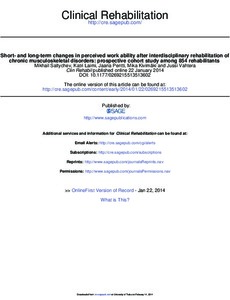Short- and long-term changes in perceived work ability after interdisciplinary rehabilitation of chronic musculoskeletal disorders: prospective cohort study among 854 rehabilitants
Mikhail Saltychev; Katri Laimi; Jaana Pentti; Mika Kivimäki; Jussi Vahtera
https://urn.fi/URN:NBN:fi-fe2021042714241
Tiivistelmä
Objective:
To investigate the changes in rehabilitants’ perceived work ability after rehabilitation for chronic musculoskeletal disorders with respect to the baseline characteristics.
Design:
Prospective cohort study based on register and repeated survey data.
Setting:
Public sector employees in ten towns and five hospital districts.
Subjects:
A total of 854 employees who participated in the rehabilitation programme owing to common chronic musculoskeletal disorders between 1997 and 2009.
Interventions:
Interdisciplinary, biopsychosocial, inpatient rehabilitation programme targeting people of working age with common chronic musculoskeletal disorders. The programme was executed in different rehabilitation centres across the country and funded by the Social Insurance Institution of Finland.
Main measures:
Differences in perceived work ability level before and after rehabilitation. Data were derived from repeated surveys on average 2.1 years before rehabilitation, and 1.5 years (short-term follow-up) and 6.0 years (long-term follow-up) after rehabilitation.
Results:
Before the rehabilitation, perceived work ability was 7.13 (SD 1.84) among the rehabilitants and 7.27 (SD 1.72) in the matched reference population. Among rehabilitants, this figure decreased by 0.82 (95% confidence interval –0.98 to −0.67) in the short-term and by 1.26 (95% confidence interval –1.45 to −1.07) in the long-term follow-up. Only slight differences in steepness of this deterioration were observed between subgroups, created based on the participants’ baseline characteristics.
Conclusions:
Perceived work ability of participants, in an interdisciplinary biopsychosocial rehabilitation programme for common musculoskeletal disorders, deteriorated regardless of any studied pretreatment characteristics. The improvement of work ability may be an unrealistic goal for participants in this type of rehabilitation.
Perceived work ability of participants, in an interdisciplinary biopsychosocial rehabilitation programme for common musculoskeletal disorders, deteriorated regardless of any studied pretreatment characteristics. The improvement of work ability may be an unrealistic goal for participants in this type of rehabilitation.
Kokoelmat
- Rinnakkaistallenteet [27094]
